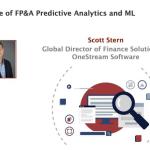This article summarises the presentations and discussions during the recent Digital FP&A Circle on how Artificial...
 During the COVID-19 lockdown, I had an opportunity to catch up with some films and came across Sully. The movie is about the emergency landing of US Airways Flight 1549 in the Hudson River. The subsequent investigation by NTSB uses computer simulations to assess the decision making and action taken by Captain Chesley "Sully" Sullenberger and his co-pilot First Officer Jeff Skiles.
During the COVID-19 lockdown, I had an opportunity to catch up with some films and came across Sully. The movie is about the emergency landing of US Airways Flight 1549 in the Hudson River. The subsequent investigation by NTSB uses computer simulations to assess the decision making and action taken by Captain Chesley "Sully" Sullenberger and his co-pilot First Officer Jeff Skiles.
Computer simulations allow us to play out various scenarios repeatedly and assess the outcomes. It is also true for computer simulations that are used in finance. Through scenario analysis, we can gain some comfort and assurance that the decision taken is the right one given the circumstances. However, there are a few considerations with the use of artificial intelligence (AI).
Knowledge vs Intelligence
A machine is deemed to demonstrate intelligence when it takes the course of action(s) that maximizes its chances of success given the environment. Intelligence should not be confused with knowledge. One who excels in a quiz show demonstrates a wide breath of knowledge. Intelligence is about the application of this knowledge in circumstances not previously experienced. It is more about problem solving and extrapolation.
Automation and Big data
In accounting and finance, you will have come across AI in the form of robotic processing automation (more commonly referred as RPA). RPA is designed to handle repetitive tasks such as journal posting to allow the finance teams to carry out more value-added activities. For those of you who remember MS Excel macro back in the 1990s, it was all the craze then because macros were used to carry out repetitive tasks in Excel at the click of a button.
As technology evolves, RPA takes on more complex and time-consuming tasks. The likes of Power BI enable quick analysis of large volume of data through some form of machine learning (ML) algorithms. This means the Finance can take on the advisory role and provide the necessary finance support for business development.
Considerations when choosing the appropriate technology
However, it is not simply about replacing people with robots when it comes to deploying technology. To ensure that the finance organisation makes the best use of technology, it is important to choose the right tool for the job as well as understand the limitations of the chosen technology. A few ways to achieve this include
Having clear objectives of what the potential tools need to achieve
Documenting and reviewing the existing process flow
Discussing with the employees the challenges of existing processes and tools
Researching the pros and cons of potential tools – discussion with peers and potential vendors
Viewing a demo of potential tool
Asking the question – what does the tool not do?
From the human factor perspective, it is important that employees are
Upskilled
Educated about the benefits (and limitations) of the technology
Engaged in the development of the technology
The workforce is the biggest asset as well as cost of an organisation. Alongside customers, the workforce is also the largest asset that an organisation can use to build its image. Therefore, when implementing new technology and new ways of working, one should consider the human factor and deploy this asset to promote business growth. Through upskilling the workforce, the organisation can generate a sense of “growing together” and drive motivation as well a job satisfaction.
The Human Factor in Decision Making
One can argue that AI and ML provide more objective decision-making environment. However, a business is made up of people, and inputs to the projections are provided by people. Therefore, when using AI and ML in decision making, the unpredictability of people should be considered. This can be achieved through
driver-based simulations
looking beyond the P&L
engaging your stakeholders
understanding the factors that impact the financials
educating the stakeholders on how their actions impact the financials
By walking this journey with the stakeholders and understanding the drivers to be used in the simulation and decision-making process, it is more likely that finance will produce a more realistic projection. Apart from producing more realistic projections, driver-based analysis also enables the business to understand the core of the controllable and non-controllable elements that impact their operations and financial results.
However, you must remember AI and ML can only produce simulations based on given circumstances. The Garbage-in Garbage-out (GIGO) concept must be noted. Any change or a new variable will mean the actual financial results can differ from a sophisticated simulation.
In summary
There are a few takeaways that you can keep in mind when using AI in decision making:
Choose the right tool for the job
Upskill your workforce
Consider the human factor
Do not forget about the GIGO concept
Disclaimer
Any views or opinions expressed are solely those of the author and do not necessarily represent those of any companies that the author has been and is working for.
Subscribe to
FP&A Trends Digest

We will regularly update you on the latest trends and developments in FP&A. Take the opportunity to have articles written by finance thought leaders delivered directly to your inbox; watch compelling webinars; connect with like-minded professionals; and become a part of our global community.






